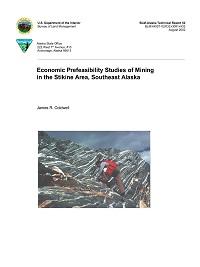Economic Prefeasibility Studies of Mining in the Stikine Area, Southeast Alaska

This report is one of a series produced in conjunction with the Bureau of Land Management’s (BLM) ongoing mineral assessment program and is authorized under the Alaska National Interest Lands Conservation Act (ANILCA, Section 1010). These studies assist the BLM in its long-term objectives for management of federal lands and mineral assets. Objectives include m aking available necessary mineral resources to m eet national, regional and local needs, considering mineral and non-mineral resource values in decision making, assuring that mineral resource exploration, development, extraction, and reclamation operations are optimized, minimizing disturbances to the environment and other resources, and assuring a fair value return to the government from the development of its mineral resources.
Mining and processing cost analyses were conducted on copper-m olybdenum porphyry, polymetallic replacement, vein gold, and volcanogenic m assive sulfide deposit types that are found in the Stikine Area. Resources and recoverable metal values (RMV) needed to make these deposits yield a 15% discounted cash flow rate-of-return (DCFROR) were modeled. Methods for estimating ore grades and RMV are presented.
Modeling for copper-molybdenum porphyry deposits indicated the RMV ranged from $29 per short ton (st) for a 31,309 short ton per day (stpd) operation supported by a 2 mile (mi) road to $63/st for a 3,913 stpd operation supported by a 30 mi road.
Modeling for polymetallic replacement deposits indicated the RMV ranged from $169/st for a 2,189 stpd operation to $490/st for a 273 stpd operation.
Modeling for vein gold deposits indicated the RMV ranged from $150/st for a 708 stpd operation to $840/st for an 89 stpd operation.
Modeling for volcanogenic massive sulfide deposits indicated the RMV ranged from $142/st for a 6,700 stpd operation to $316/st for an 837 stpd operation.
